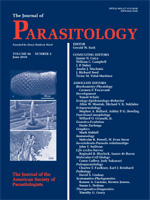Control of Strongyloides stercoralis infection is based on antihelminthic treatment. However, the development of an efficient vaccine is an important goal for more effectively managing this disease. Different Strongyloides spp. antigen preparations have been previously tested but without satisfactory results. In the present study, we evaluated whether the doxycholic acid extract of Strongyloides venezuelensis stage 3 larvae was able to protect CD1 mice against a homologue infection. Moreover, we included saponins from Quillaja saponaria (Qs) and immunomodulatory substances, i.e., Phlebodium pseudoaureum hydroalcoholic extract (PAL) or the amino alcohol AA0029, which has an aliphatic chain of 14 carbon atoms with a hydrophilic amino alcohol head, where the amino group is protected with a butoxycarbonyl group. The DOCSv antigen, together with the adjuvant components, was emulsified in a non-mineral water/oil emulsion. We performed duplicate experiments with each of the 2 immunomodulators. The DOCSv antigen used with Qs PAL induced high levels of protection in terms of fecal egg count reduction (93.2–99.4%), 86–88% in adult worm recovery, and reduction in swelling of the small intestine. Mice vaccinated with the DOCSv antigen, together with Qs AA0029, showed a 73.7–97.0% reduction in fecal egg count, with reduction in inflammation of the small intestine. High levels of IgG and IgG2a were observed in mice vaccinated with Qs AA0029 DOCSv, indicating a Th1 immune response. Also, vaccinated mice recognized bands of 34, 39, 43, 95, and 170 kDa in a Western blot.
How to translate text using browser tools
1 June 2010
Vaccination Against Strongyloides venezuelensis with Homologue Antigens Using New Immunomodulators
Johnny Vlaminck,
Julio López-Abán,
Ana Lucía Ruano,
Esther del Olmo,
Antonio Muro
ACCESS THE FULL ARTICLE

Journal of Parasitology
Vol. 96 • No. 3
June 2010
Vol. 96 • No. 3
June 2010




